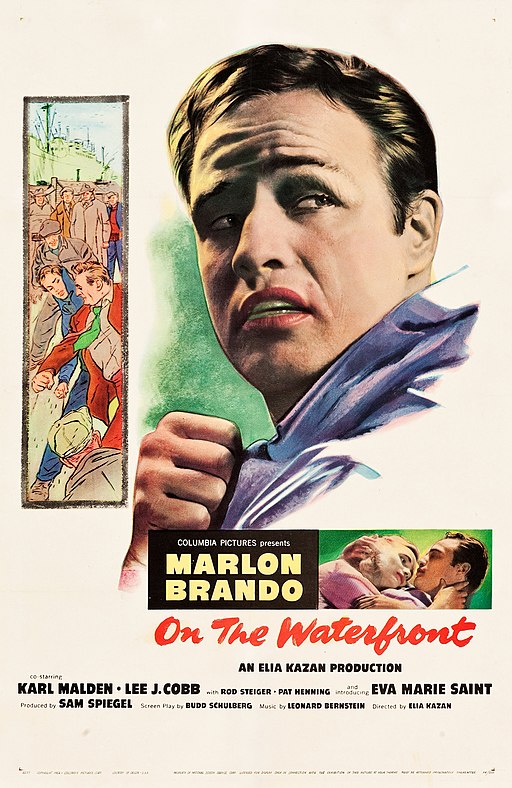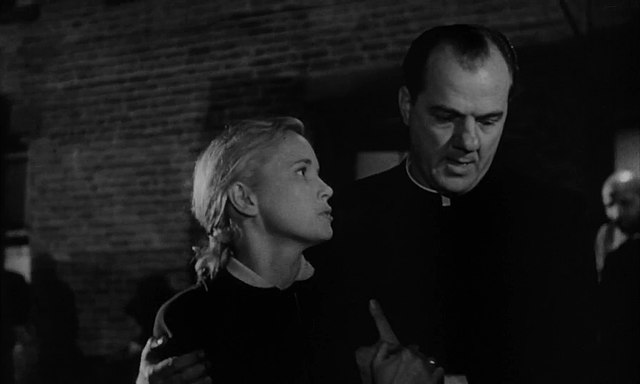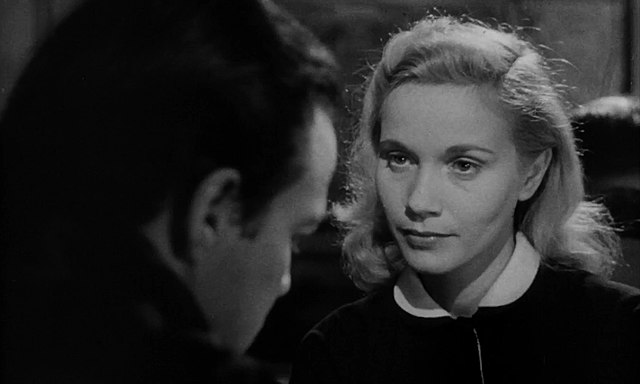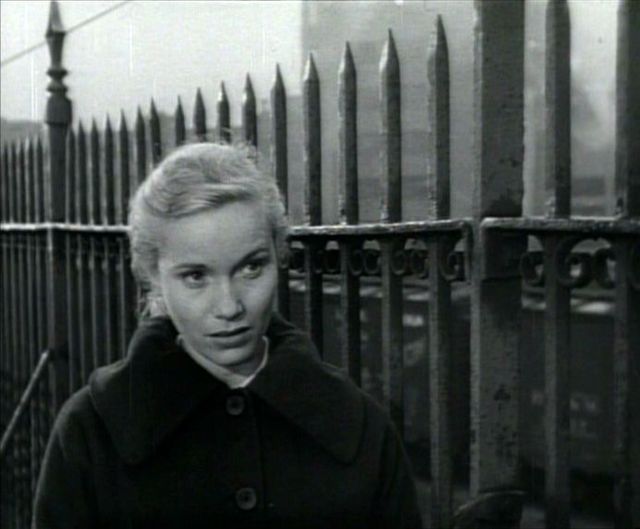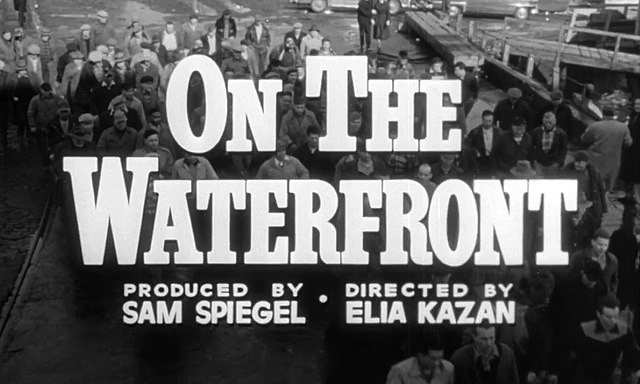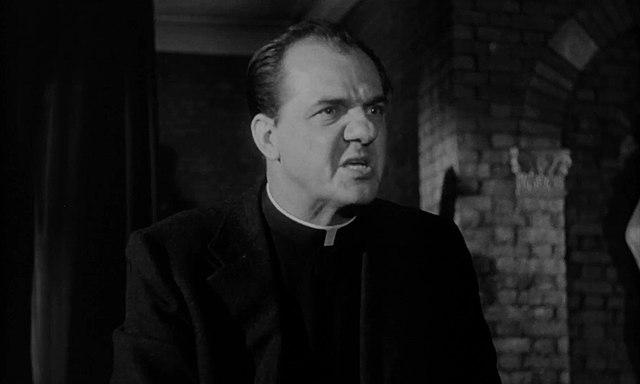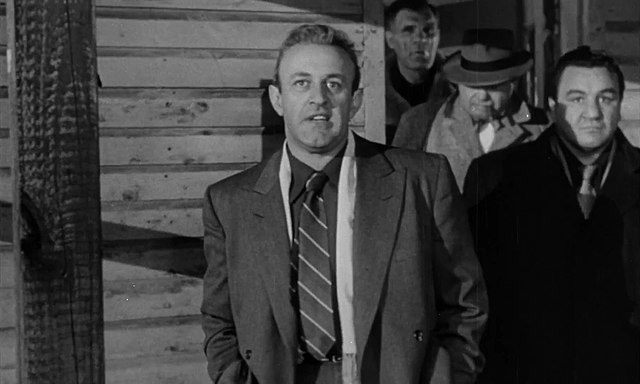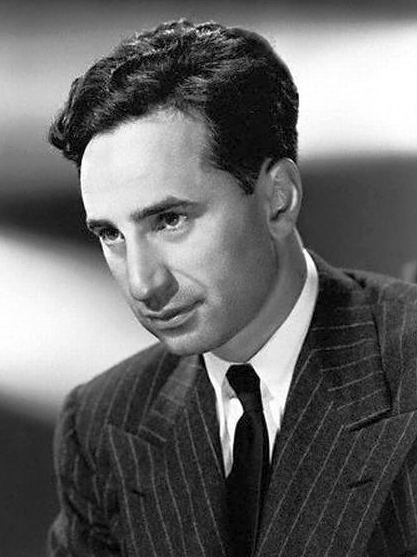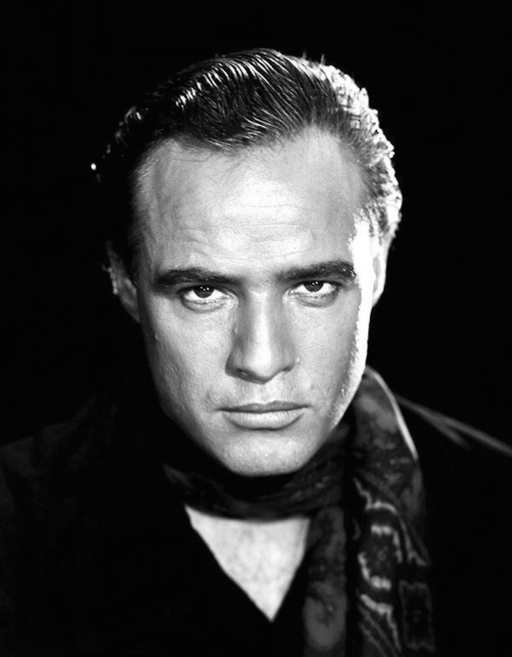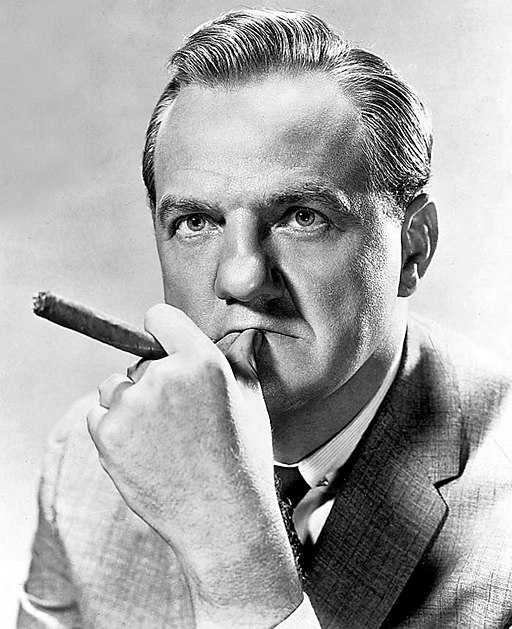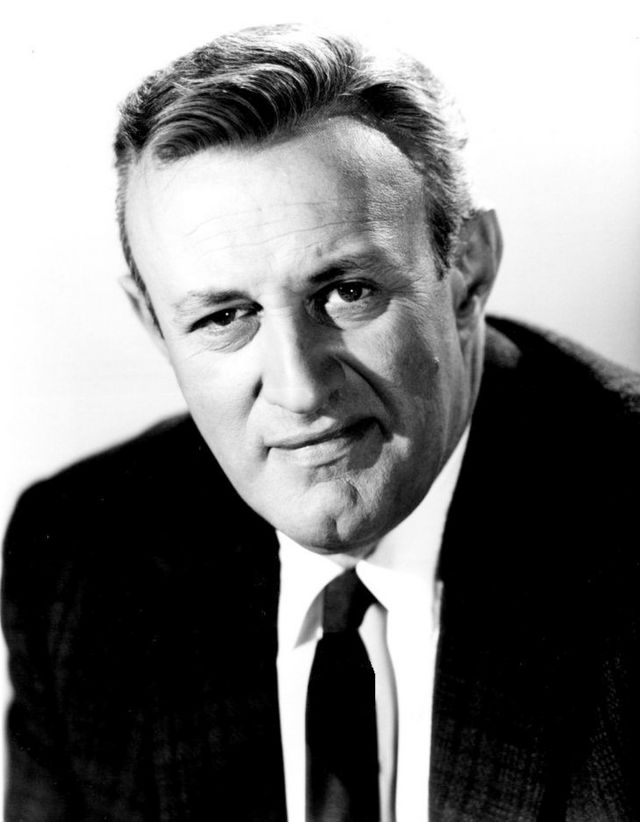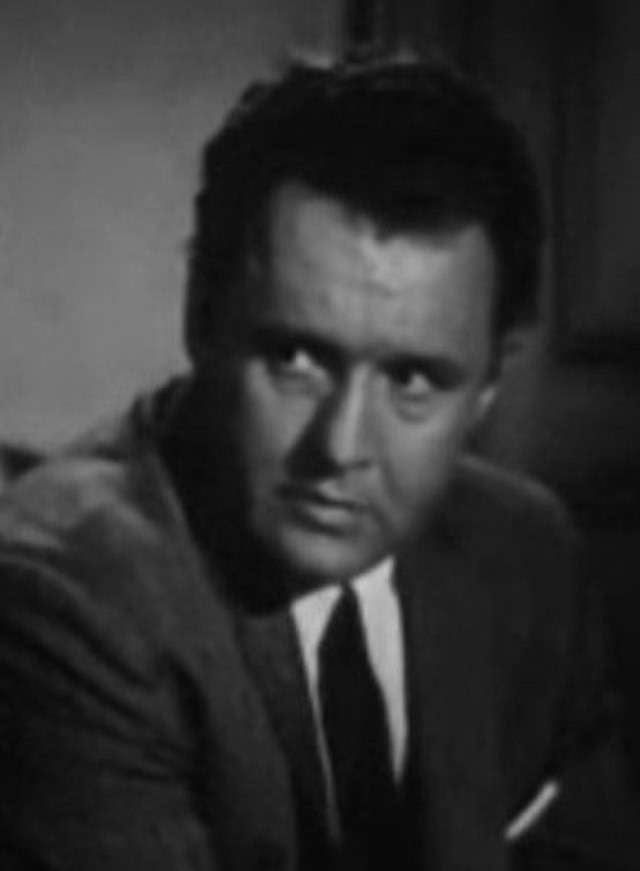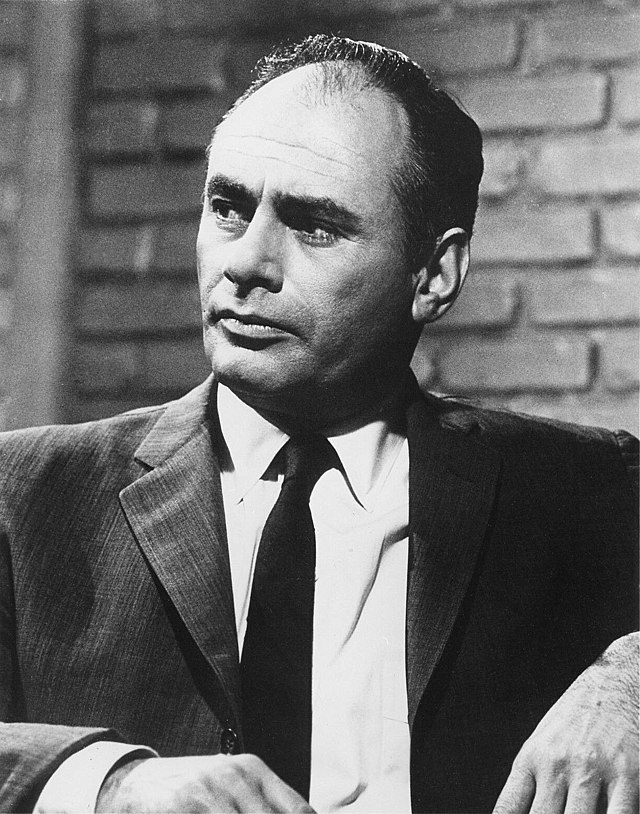On The Waterfront - 1954
back| Released by | Columbia Pictures |
| Director | Elia Kazan |
| Producer | Sam Spiegel |
| Script | Budd Schulberg |
| Cinematography | Boris Kaufman |
| Music by | Leonard Bernstein |
| Running time | 108 minutes |
| Film budget | $910,000 |
| Box office sales | $9.6 million |
| Main cast | Marlon Brando - Karl MAlden - Lee J. Cobb - Rod Steiger - Eva Marie Saint |
On The Waterfront
A Gripping Tale of Redemption and Courage against Systemic Corruption
On The Waterfront (1954), directed by Elia Kazan, follows Terry Malloy (Marlon Brando), a former boxer turned dockworker, as he grapples with his conscience after being involved in a corrupt union's murder of a fellow worker.
Encouraged by the determined Edie Doyle (Eva Marie Saint) and the principled Father Barry (Karl Malden), Terry decides to testify against the ruthless union boss Johnny Friendly (Lee J. Cobb). The film's raw portrayal of corruption, moral struggle, and redemption, coupled with Brando's iconic performance, set new standards for method acting and cinematic realism.
Related
On The Waterfront – 1954
Summary and Analysis
On The Waterfront is a powerful drama set against the backdrop of union corruption on the New Jersey docks. The film follows Terry Malloy (Marlon Brando), a former prizefighter who now works as a longshoreman. Terry is initially a pawn for the corrupt union boss Johnny Friendly (Lee J. Cobb) and his right-hand man, Terry's brother Charley (Rod Steiger).
The story begins with the murder of Joey Doyle, a dockworker who planned to testify against Friendly's illegal activities. Terry is used by Friendly to lure Joey to his death, unaware of the true intentions behind his involvement. Joey's sister, Edie Doyle (Eva Marie Saint), seeks justice for her brother's murder and begins to uncover the corruption within the union.
As Edie and Terry grow closer, Terry's conscience is awakened. Encouraged by Edie and Father Barry (Karl Malden), a local priest determined to fight the union's corruption, Terry starts to question his loyalty to Friendly and the choices he has made. Father Barry's impassioned speech in the hold of a ship, where he calls out the dockworkers for their complicity, serves as a turning point for Terry.
Terry's transformation from a reluctant bystander to a man willing to stand up for what is right is depicted in his decision to testify against Friendly, despite the personal risks. This decision culminates in a climactic confrontation where Terry is brutally beaten but refuses to back down. In the end, Terry's stand inspires his fellow dockworkers to break free from Friendly's grip, symbolizing a victory for justice and individual courage.
Analysis:
On The Waterfront is a deeply layered film that explores themes of morality, redemption, and the power dynamics within corrupt systems. Directed by Elia Kazan, the film is often seen as an allegory for Kazan's own controversial decision to testify before the House Un-American Activities Committee, naming former colleagues as communists.
Character Development:
- Terry Malloy: Marlon Brando's portrayal of Terry Malloy is central to the film's impact. Terry is initially portrayed as a conflicted character, torn between his loyalty to his brother and his burgeoning sense of justice. Brando's nuanced performance, highlighted in scenes such as the iconic "I coulda been a contender" speech, captures Terry's inner turmoil and eventual resolve.
- Edie Doyle: Eva Marie Saint's Edie serves as the moral compass of the film. Her innocence and determination to seek justice for her brother's murder catalyze Terry's transformation. Edie represents the possibility of redemption and the impact of personal integrity.
- Father Barry: Karl Malden's Father Barry is a beacon of moral clarity in the corrupt world of the docks. His speeches, particularly the one in the ship's hold, serve to galvanize the dockworkers and underscore the film's themes of collective responsibility and courage.
Themes:
- Corruption and Power: The film vividly depicts the stranglehold that corrupt union leaders have over the dockworkers. Johnny Friendly's tyranny is a microcosm of larger societal issues, showcasing how power can corrupt and the difficulty of challenging entrenched systems.
- Individual vs. Collective: Terry's journey from isolation to solidarity is a key narrative arc. Initially a pawn and bystander, Terry's decision to testify represents the triumph of individual courage over collective apathy.
- Redemption: Central to Terry's story is his quest for redemption. His involvement in Joey's murder haunts him, and his eventual stand against Friendly is both an act of atonement and a reclaiming of his dignity.
Cinematography and Music:
- Boris Kaufman's cinematography captures the gritty realism of the docks, employing stark contrasts and tight framing to emphasize the characters' emotional states. The use of on-location shooting in Hoboken, New Jersey, adds authenticity to the film's atmosphere.
- Leonard Bernstein's score enhances the emotional intensity of the narrative. The music underscores key moments, from the romantic scenes between Terry and Edie to the tense confrontations with Friendly.
Cultural Impact: On The Waterfront is widely regarded as one of the greatest American films. It received numerous accolades, including eight Academy Awards, and solidified Marlon Brando's status as one of the foremost actors of his generation. The film's exploration of ethical dilemmas and its reflection on personal and societal responsibility continue to resonate with audiences today.
In conclusion, On The Waterfront is a compelling exploration of courage, redemption, and the fight against corruption. Its rich characterizations, powerful performances, and enduring themes make it a timeless classic in American cinema.
Classic Trailer from On The Waterfront:
Full Cast:
· Marlon Brando as Terry Malloy
· Karl Malden as Father Barry
· Lee J. Cobb as Johnny Friendly
· Rod Steiger as Charley Malloy
· Pat Henning as Timothy J. "Kayo" Dugan
· Eva Marie Saint as Edie Doyle
· John F. Hamilton as 'Pop' Doyle
· John Heldabrand as Mott
· Leif Erickson as Glover
· James Westerfield as Big Mac
· Tony Galento as Truck
· Tami Mauriello as Tullio
· Michael V. Gazzo as Joe Doyle
· Martin Balsam as Gillette
· Rudy Bond as Moose
· Don Blackman as Luke
· Arthur Keegan as Jimmy
· Abe Simon as Barney
· Thomas Handley as Tommy Collins
· Sonny Jim Gaines as Slim
Masterful Direction of Elia Kazan:
Elia Kazan's direction in On The Waterfront is a masterclass in storytelling, blending naturalistic performances with a gritty, realistic portrayal of life on the docks. His approach to the film's narrative, character development, and visual style underscores the thematic depth and emotional intensity of the story.
Visual Style and Cinematography:
Kazan's collaboration with cinematographer Boris Kaufman resulted in a visual style that is both raw and evocative. The use of on-location shooting in Hoboken, New Jersey, adds a layer of authenticity to the film. The docks, rooftops, and tenements are not just backdrops but integral to the film's atmosphere, reflecting the harsh, oppressive environment in which the characters live and work.
Kaufman's use of high-contrast lighting and tight framing emphasizes the emotional and physical confinement of the characters. Close-ups of Marlon Brando's face, for example, highlight the internal conflict and vulnerability of Terry Malloy. Kazan's decision to shoot in black and white further enhances the starkness of the setting, creating a visual metaphor for the moral black-and-white choices the characters face.
Naturalistic Performances:
Kazan's background in theater, particularly his association with the Group Theatre and the Actors Studio, heavily influenced his direction. He championed the Method acting approach, which encourages actors to draw on their own experiences and emotions to deliver authentic performances. This technique is evident in the film's standout performances, particularly Marlon Brando's portrayal of Terry Malloy.
Brando's iconic "I coulda been a contender" scene with Rod Steiger is a testament to Kazan's ability to elicit deep, nuanced performances from his actors. The scene's improvisational feel and emotional rawness stem from Kazan's encouragement of spontaneity and realism, allowing the actors to inhabit their characters fully.
Character Development:
Kazan's direction meticulously develops the characters' arcs, ensuring that their motivations and transformations are believable and compelling. Terry Malloy's journey from a conflicted, passive dockworker to a courageous whistleblower is central to the narrative. Kazan carefully builds this transformation, using key interactions with Edie Doyle (Eva Marie Saint) and Father Barry (Karl Malden) to catalyze Terry's awakening.
Father Barry's character, portrayed with conviction by Karl Malden, serves as the moral backbone of the film. Kazan's direction ensures that Father Barry's speeches, particularly the one in the hold of a ship, resonate powerfully with both the characters and the audience. These moments are not just plot devices but pivotal points that drive the characters toward their eventual actions.
Thematic Depth:
Kazan deftly weaves the film's themes of corruption, redemption, and individual versus collective responsibility into the narrative. His direction emphasizes the moral stakes at play, making the characters' decisions deeply impactful. The film's portrayal of union corruption serves as a broader commentary on power dynamics and the struggles of the working class.
The theme of redemption is central to Terry's story, and Kazan handles it with subtlety and sensitivity. Terry's guilt over his involvement in Joey Doyle's murder and his subsequent quest for atonement are portrayed with emotional depth, making his final stand against Johnny Friendly (Lee J. Cobb) both a personal and symbolic victory.
Impactful Scenes:
Kazan's direction is marked by several memorable scenes that encapsulate the film's emotional and thematic core:
- The Opening Sequence: The film opens with the murder of Joey Doyle, setting the tone for the narrative. Kazan's direction here is taut and suspenseful, immediately drawing the audience into the world of the docks.
- Father Barry's Sermon: Delivered in the hold of a ship, this scene is a powerful indictment of the dockworkers' complicity and a call to action. Kazan's direction emphasizes the intensity of Father Barry's words and the reactions of the listeners, making it a turning point in the film.
- The Climactic Confrontation: The final showdown between Terry and Friendly is brutal and visceral. Kazan's direction ensures that the physical confrontation is not just a fight but a symbolic battle for justice and integrity.
Elia Kazan's direction in On The Waterfront is a harmonious blend of naturalistic performances, authentic settings, and thematic depth. His ability to draw powerful performances from his actors, combined with his keen eye for visual storytelling, results in a film that is both a gripping drama and a poignant exploration of moral courage. Kazan's personal experiences and convictions imbue the film with a sense of urgency and authenticity, making On The Waterfront a timeless classic that continues to resonate with audiences.
Analysis of Marlon Brando's Performance in On The Waterfront (1954)
Marlon Brando’s performance as Terry Malloy in On The Waterfront is often hailed as one of the greatest in cinematic history. His portrayal of a conflicted, brooding dockworker who seeks redemption is a masterclass in method acting, bringing a raw authenticity to the role that has influenced countless actors since.
Character Complexity:
Brando’s Terry Malloy is a character of profound depth and complexity. From the outset, Terry is presented as a man torn between his loyalty to his brother and the corrupt union, and his emerging conscience. Brando captures this internal struggle with subtlety and nuance. His physicality and expressions convey a man burdened by guilt and longing for a better life, even before the character vocalizes these emotions.
Physicality and Presence:
Brando’s physical presence is a significant aspect of his performance. His background as a former boxer is evident in his demeanor and movement. He carries himself with a mixture of strength and vulnerability, a man whose past glories in the ring contrast sharply with his current reality on the docks. This physicality is not just in the obvious scenes of labor or confrontation but in quieter moments, where his body language speaks volumes about his internal state.
Nuanced Emotions:
One of Brando’s strengths is his ability to convey a wide range of emotions with remarkable subtlety. In scenes where Terry is wrestling with his conscience, Brando’s facial expressions, especially his eyes, communicate a depth of feeling that words alone could not capture. This is particularly evident in his interactions with Edie Doyle (Eva Marie Saint) and Father Barry (Karl Malden). His gradual transformation from a reluctant participant in the corruption to a man willing to stand up for what is right is portrayed with a natural progression that feels deeply authentic.
Iconic Scenes:
Several scenes in On The Waterfront showcase Brando’s exceptional talent:
- The "Contender" Speech: The taxi cab scene with Rod Steiger (Charley Malloy) is one of the most iconic in film history. Brando’s delivery of the line, “I coulda been a contender. I coulda been somebody,” is heartbreakingly sincere. His emotional honesty in this moment captures Terry’s regret and longing for a life untainted by corruption. The interplay between Brando and Steiger, both method actors, creates an intensely personal and poignant exchange.
- The Confrontation with Johnny Friendly: In the film’s climax, Brando’s physical and emotional resilience is on full display. Even as Terry is beaten, his determination and moral clarity shine through. Brando’s portrayal of Terry’s defiance in the face of brutality is both powerful and inspiring.
- Intimate Moments with Edie: Brando’s chemistry with Eva Marie Saint adds a tender dimension to the film. His portrayal of Terry’s burgeoning love for Edie is filled with genuine warmth and vulnerability. These scenes humanize Terry and provide a counterpoint to the harshness of the dockworkers’ world.
Method Acting Influence:
Brando’s performance is a testament to the effectiveness of method acting, which he helped popularize. Drawing from personal experiences and immersing himself fully in the role, Brando brings an unparalleled realism to Terry Malloy. His approach influences his line delivery, gestures, and interactions with other characters, making every scene feel spontaneous and real.
Cultural and Industry Impact:
Brando’s work in On The Waterfront not only garnered critical acclaim, winning him the Academy Award for Best Actor, but also had a lasting impact on the craft of acting. His portrayal of Terry Malloy set a new standard for screen acting, emphasizing emotional truth and psychological depth over theatricality. This shift towards a more naturalistic and introspective style influenced a generation of actors and filmmakers, solidifying Brando’s legacy as a transformative figure in cinema.
Marlon Brando’s performance in On The Waterfront is a tour de force of acting prowess. Through his nuanced portrayal of Terry Malloy, Brando conveys a rich tapestry of emotions, embodying the character’s struggles, regrets, and ultimate quest for redemption. His method acting approach brings an unparalleled authenticity to the role, making Terry’s journey profoundly compelling and relatable. Brando’s work in this film remains a benchmark for actors and a testament to his extraordinary talent and influence in the world of cinema.
Notable Quotes from “On The Waterfront”:
· Terry Malloy: "I coulda been a contender. I coulda been somebody, instead of a bum, which is what I am."
· Father Barry: "You want to know what's wrong with our waterfront? It's the love of a lousy buck. It's making love of a buck — the cushy job — more important than the love of man!"
· Edie Doyle: "Which side are you with?"
· Johnny Friendly: "You think you're God Almighty, but you know what you are? You're a cheap, lousy, dirty, stinking mug! And I'm glad what I've done to you. You hear that? I'm glad what I've done!"
· Father Barry: "If you don't think Christ is down here on the waterfront, you've got another guess coming!"
· Terry Malloy: "You don't understand. I coulda had class. I coulda been a contender. I coulda been somebody, instead of a bum, which is what I am, let's face it."
· Charley Malloy: "Look, kid, I — how much you weigh, son? When you weighed 168 pounds, you were beautiful. You could have been another Billy Conn. And that skunk we got you for a manager, he brought you along too fast."
· Father Barry: "Some people think the Crucifixion only took place on Calvary. They better wise up! Taking Joey Doyle's life to stop him from testifying is a crucifixion. And dropping a sling on Kayo Dugan because he was ready to spill his guts tomorrow — that's a crucifixion. And every time the mob puts the crusher on a good man, tries to stop him from doing his duty as a citizen — it's a crucifixion."
· Terry Malloy: "I'm standing over here now. I was rattin' on myself all those years. I didn't even know it."
· Edie Doyle: "There’s more to this than I thought."
Classic Scenes:
The "Contender" Scene
Location: In a taxicab Characters: Terry Malloy (Marlon Brando) and Charley Malloy (Rod Steiger) Significance: This is perhaps the most famous scene in the film and one of the most iconic in movie history. In this scene, Terry confronts his brother Charley, lamenting how he was manipulated into throwing fights, thus derailing his promising boxing career. Terry's line, "I coulda been a contender. I coulda been somebody, instead of a bum, which is what I am," poignantly captures his deep regret and lost potential. Brando's delivery is heartfelt and raw, making this moment a defining one for both his character and the film.
Father Barry's Sermon
Location: In the hold of a ship Characters: Father Barry (Karl Malden), Terry Malloy, and other dockworkers Significance: After the death of dockworker Kayo Dugan, Father Barry delivers a powerful sermon to the other workers, calling out their complicity and the corrupt union practices. He compares the suffering and sacrifice of the workers to the crucifixion of Christ, urging them to stand up against the corruption. Malden's impassioned performance underscores the moral weight of the scene, marking a turning point in the film where the workers begin to reconsider their roles.
The Rooftop Pigeon Scene
Location: On a rooftop Characters: Terry Malloy and Edie Doyle (Eva Marie Saint) Significance: This scene shows Terry caring for his pigeons and having a heartfelt conversation with Edie. It highlights Terry's vulnerability and the growing bond between him and Edie. The pigeons symbolize Terry's own longing for freedom and innocence, contrasting with the corruption and violence he faces daily. This tender interaction adds depth to Terry's character and builds the romantic subplot.
The Confrontation with Johnny Friendly
Location: On the docks Characters: Terry Malloy and Johnny Friendly (Lee J. Cobb) Significance: In the film's climax, Terry confronts Johnny Friendly and publicly accuses him of murder and corruption. Despite being brutally beaten by Friendly's men, Terry's stand inspires the other dockworkers to rally behind him. His resilience and courage in the face of violence signify his complete transformation and redemption. This scene serves as a powerful conclusion to Terry's journey from a reluctant participant in corruption to a hero standing up for justice.
Terry's Confession to Edie
Location: In a bar Characters: Terry Malloy and Edie Doyle Significance: Terry admits to Edie that he was involved in her brother Joey's murder. This confession is a pivotal moment for both characters. For Terry, it's a step towards redemption and taking responsibility for his actions. For Edie, it’s a moment of betrayal and deep emotional conflict. The tension and raw emotion in this scene highlight Brando and Saint's exceptional performances.
The Final Walk
Location: The docks Characters: Terry Malloy and the dockworkers Significance: After the confrontation and beating, Terry, battered and bruised, struggles to his feet and walks towards the docks to work. The other dockworkers, inspired by his bravery, follow him, symbolizing their collective break from Friendly's control. This scene represents a victory for the workers and the triumph of individual courage over systemic corruption. The music and cinematography amplify the emotional impact, making it a powerful and uplifting conclusion to the film.
The Opening Sequence
Location: The docks Characters: Joey Doyle and various dockworkers Significance: The film opens with the murder of Joey Doyle, which sets the stage for the entire narrative. Joey is pushed off a rooftop for planning to testify against the corrupt union. This event catalyzes the unfolding drama, highlighting the dangerous stakes and the pervasive corruption on the waterfront.
Awards and Recognition for On The Waterfront:
Academy Awards (1955)
Won:
- Best Picture - Sam Spiegel
- Best Director - Elia Kazan
- Best Actor in a Leading Role - Marlon Brando
- Best Actress in a Supporting Role - Eva Marie Saint
- Best Screenplay - Budd Schulberg
- Best Art Direction-Set Decoration, Black-and-White - Richard Day
- Best Cinematography, Black-and-White - Boris Kaufman
- Best Film Editing - Gene Milford
Nominated:
- Best Actor in a Supporting Role - Lee J. Cobb
- Best Actor in a Supporting Role - Karl Malden
- Best Actor in a Supporting Role - Rod Steiger
- Best Music, Scoring of a Dramatic or Comedy Picture - Leonard Bernstein
- Best Costume Design, Black-and-White - Anna Hill Johnstone
Golden Globe Awards (1955)
Won:
- Best Motion Picture – Drama
- Best Actor in a Motion Picture – Drama - Marlon Brando
- Best Director - Elia Kazan
British Academy Film Awards (BAFTA) (1955)
Won:
- Best Actor in a Foreign Film - Marlon Brando
- Best Film from any Source
Nominated:
- Best Foreign Actor - Rod Steiger
- Best Foreign Actress - Eva Marie Saint
Cannes Film Festival (1954)
Won:
- OCIC Award - Elia Kazan
Nominated:
- Palme d'Or - Elia Kazan
Directors Guild of America (DGA) Awards (1955)
Won:
- Outstanding Directorial Achievement in Motion Pictures - Elia Kazan
Writers Guild of America (WGA) Awards (1955)
Won:
- Best Written American Drama - Budd Schulberg
New York Film Critics Circle Awards (1954)
Won:
- Best Film
- Best Director - Elia Kazan
- Best Actor - Marlon Brando
National Board of Review Awards (1954)
Won:
- Best Film
- Best Director - Elia Kazan
- Best Actor - Marlon Brando
- Best Supporting Actress - Eva Marie Saint
Laurel Awards (1955)
Won:
- Top Drama
Other Honors:
- AFI's 100 Years...100 Movies (1998): Ranked #8
- AFI's 100 Years...100 Movies (10th Anniversary Edition) (2007): Ranked #19

